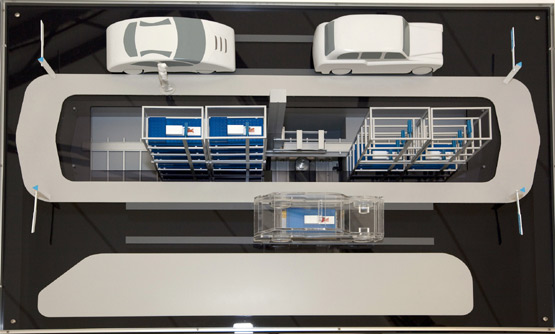Batteries NOT included
on
Batteries NOT included
Leading IT entrepreneur Shai Agassi’s company Better Place has teamed up with Renault Nissan to develop a unique business model for rolling out the electric car. Under their pioneering scheme the car’s battery remains the property of the provider.
 |
|
Model of battery switching station. Photo: Better Place |
Electric motoring will only take off if drivers can feel confident that they won’t be left stranded with an empty battery. And if the cost per kilometre is no higher – and preferably lower – than it is now. That just about sums up the philosophy behind US company Better Place, which has committed itself to conquering the world with the electric car: electric cars need to be practical and affordable.
The company has plumped for Israel as the first target market in which to realise its ambitions. A central principle of its business model is the battery exchange station. The IT company likes to compare the roll-out of electric cars to the introduction of mobile telephony: demand only picks up once cover extends across an entire country. In much the same way, drivers will only opt for electric motoring once there are enough battery swap stations to guarantee full mobility. In Israel there are plans for 150 stations where motorists can swap their empty battery for a fully charged one. The infrastructure must be in place some six months before the large-scale roll-out of the electric models. The cars’ batteries are deemed to be part of this infrastructure and remain the property of Better Place. Customers pay a monthly fee to cover overheads, and for the distances travelled. Thanks to economies of scale and Israeli tax breaks, the costs per kilometre of running an electric car are no higher than those for diesel or petrol-driven vehicles. Israel levies a purchase tax of 95 percent on cars with a combustion engine. For electric cars, the tax will be just 10 percent.
Seated in Better Place’s recently opened, hypermodern Tel Aviv offices, research and development director Dr. Barak Hershkovitz expounds on the company’s plans. A staff of 75 is already working full-time on preparations for the launch. Hershkovitz, who graduated as an opthamologist but has spent his entire working life in the IT industry, says he decided immediately he wanted in on the project when he saw the vision document on Better Place drafted by Shai Agassi, the famous IT entrepreneur. ‘It was not just a new job,’ Hershkovitz says simply. ‘I became part of a mission.’
A couple of years ago Better Place still ranked as a ‘project’, but these days it’s a business that has already managed to attract some $200 million in investment in Israel for the product launch alone. The projected return on investment (ROI) based on the fees to be paid by clients was sufficiently compelling to persuade major players such as Israel Corp. and Vantage Point Venture Partner to become investors. ‘It’s a large sum of money, but it only buys three months of fuel for Israel’s current fleet of cars,’ Hershkovitz explains.
Hershkovitz describes Better Place as ‘essentially a services company’, adding, ‘we have subscribers who pay a monthly fee.’ The Better Place services concept is supported by an advanced software system called Autos. The batteries, the vehicles, the battery swap stations and other charge spots are all linked to a central database. When motorists tap a destination into their satellite navigation system that’s further away than the battery can handle, Autos recommends locations where the battery can be swapped for a fully-charged one. Autos also establishes that the new battery will be standing there ready on arrival. And if the motorist changes plans en route, then Autos is on hand with a new recommendation.
Robotic arms
Using a demonstration model at the Tel Aviv office, Hershkovitz illustrates how Atos instructs the driver. Only when the driver has repeatedly ignored Autos’ recommendations does the car grind to a stop. But then there’s always the service vehicle that can be called to the scene to swap batteries on the spot, much like a traditional breakdown service.
Autos also takes care of the billing, based on the number of kilometres travelled. Big Brother is watching you? Hershkovitz: ‘Right now, your mobile telephony provider also knows just where your mobile is, and which calls you’re making. But the service provider doesn’t know what your phone conversations are about. As we see it, Autos works much the same way. The service provider doesn’t know what you’re using the car for. But Autos does know where the car is, and the kind of service it requires. Incidentally we’ve recently taken on a security expert to manage these sorts of issues.’
Just like the software programme, the battery swap stations have long passed the design stage. In May this year Better Place unveiled its prototype at a trade fair organised in Yokohama by the Japanese ministry for the environment. The car drives into the swap station. Robotic arms reach under the car and remove the battery, replacing it with a fully-charged one. It takes just one and a half hours to recharge the used battery, which means that only a limited number of batteries need to be kept in stock. Switching batteries takes a total of just three minutes – less time than it takes to fill a petrol tank.
But the electric cars must of course be designed in such a way as to make such fast battery swaps possible. To achieve this, Better Place has teamed up with carmaker Renault-Nissan. The company has taken a conscious decision to re-engineer existing models to ensure that consumers are faced with as few changes as possible when they switch to electric motoring. Currently Better Place is also conducting negotiations with other industry players, but Renault-Nissan is slated to stay the company’s ‘most strategic partner’. Hershkovitz: ‘With this strategic choice, Renault-Nissan’s ceo has made an amazing move. I predict that Renault-Nissan will play a similar role to that of Ford in the Twenties in the conventional auto industry. By 2011 Renault-Nissan will be the world’s biggest supplier of electric powered vehicles.’
Random charging
It will be quite a challenge to supply the power for all these new cars – not just when it comes to the generation, but also the distribution. Better Place commissioned energy supplier Israel Electric Corporation to research the implications of putting two million electric cars on the road in Israel by 2020, around 50 percent of the country’s current vehicle fleet. The resultant study posits three scenarios: charging completely at random, random charging with incentives for users charging batteries during off-peak hours and centrally regulated charging. The first scenario would require additional generating capacity of some 2345 MW (equal to six smaller gas-fired power stations or three large-scale coal-powered plants). In the case of an incentives-linked regime, the additional capacity required declines to 1770 MW. In centrally regulated scenario no additional generating capacity is needed at all.
The scenarios show a similar breakdown when it comes to investment in the networks. All scenarios require investment in transformer stations and medium and low voltage cables, but in the third scenario such investments are significantly lower. In practice consumers will experience few differences whatever scenario plays out, says Better Place, although they will have to make sure cars are hooked up to the charger when not in use. As such the home charger also forms part of the Better Place infrastructure.
General Motors has opted for a completely different way of extending its operations radius with its Chevy Volt and Opel Ampera models. The first 70 kilometres of a journey are powered electrically, after which the combustion engine takes over. Based on this principle, around 80 percent of passenger transport kilometres would be electric, the US automobile giant reckons. But Hershkovitz counters that GM’s dual drive systems make the cars prohibitively expensive. With a price tag of $55,000, the Chevy Volt will only interest a niche market, he argues. And the GM solution does nothing to eliminate the dependence on fossil fuels – one of Better Place’s founding ideals.
Why has Better Place opted to start out in Israel? ‘Because of President Shimon Peres,’ Hershkovitz answers without hesitation. ‘Peres was a supporter from the start. Israel is always striving for leadership, and not only in electric cars. That’s why it’s an early adopter. And the favourable tax regime is important. The electric car fits with Israel’s ambitions to become totally oil-independent. Last but not least, it’s a small country and distances are relatively short. That facilitates the cars’ introduction.’
The second market where Better Place plans to roll out its concept is Denmark. The Danish tax on cars with petrol or diesel engines amounts to a hefty 180 percent. For electric cars that tax will be set at nought, the Danish government has already announced. And after Denmark, where does Better Place plan to go next? ‘There are a number of countries in the pipeline, including Australia. We’ll choose a country that’s willing to support us with a friendly tax scheme, where the utility provider is committed, where there’s money and where there are manufacturers of electric vehicles.’
|
‘Governments want this transition’
Have you succeeded already in attracting finance? What do you say to those who are sceptical about electric cars? How fast could it happen in Denmark? But electric cars are still more expensive to produce than regular gasoline or diesel cars. What about the car companies? |



Discussion (0 comments)